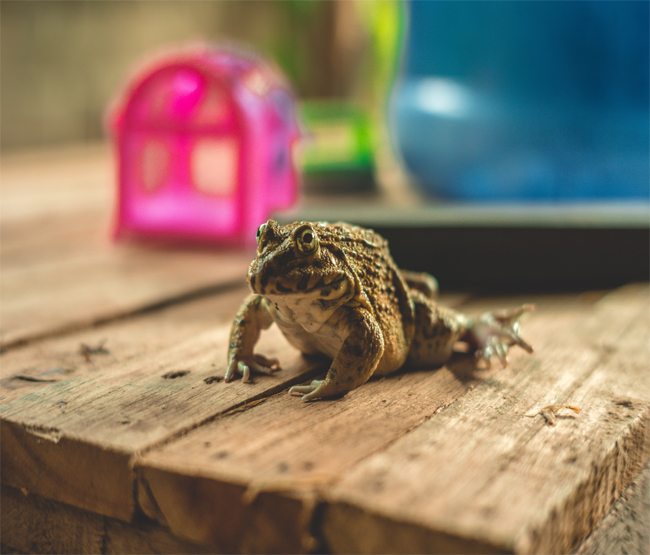Pacman frogs get their name because of how much they look like the pacman from video games – they have the same giant mouth and round face!
When you get a common pet like a dog or a cat, almost everyone around you knows what to do, but knowledge about how to take care of pets like the pacman frog and other reptiles is certainly less common. Of course, this is where online resources like this one come into the picture.
First things first – not all reptiles are going to love humid conditions and need a lot of water in their habitats, just like how not all kinds of dogs need the same kind of food and care. There are some general rules to keeping reptiles as pets that we’re going to talk about at the end of the article, but for the most part, you might want to look into the details of taking care of the specific kind of reptilian pet you’re thinking of getting.
The Habitat
Pacman frogs are one of the only kinds of frogs who are fully terrestrial, which means they won’t need any deep bodies of water. What they will need, however, is a small area (a ten to twenty gallon tank would do) that’s full of real or artificial plants that they can hide behind. You might need to buy some branches from the store for this habitat as well, and sprinkle the floor with two to four inches of coconut fiber or bark bedding for them to burrow into.
You should also provide your frog with some water, but make the puddle shallow enough that the frog can sit inside without being submerged – just a few centimeters will do.
The temperature of the habitat needs to be around 82 F during the day and around 78 F at night. The area needs to be heated from below the surface because overhead lights etc might make the area too dry for your frog – you need to keep the humidity in your frog’s home between 50% to 80%.
Keep the light in the habitat on for 12 hours in the day and off for the other 12.
If all this sounds confusing, experts like Everything Reptiles can help you with pacman frogs, including setting up the right habitat for them when you first get yours.
What Do They Eat?
Pacman frogs aren’t picky eaters at all. In fact, they’ll eat each other if one’s bigger than the other! Anything that comes close to them is fair game. This is part of why you can’t keep a number of them at a time, and they do eat other smaller frogs for food too sometimes.
Smaller frogs can be fed insects like crickets, worms, and other store bought insect meals. They need to be fed everyday, but the frequency will need to decrease when they get older.
For adult frogs, newborn mice, small frogs, guppies, and other insects can be good meals. You need to feed them once every two to three days. A general rule to follow here is that if your frog is looking too round or bloated near the stomach, it’s time to feed it less often!
Pacman frogs are rarely ever going to say no to food, which is why if that happens, you need to make sure your frog is okay – a trip to the vet might be needed.
Do They Make Good Pets?

That depends on what you’re looking for in a pet. If you’re looking for one you can interact with and play around with often, a Pacman frog might disappoint you. They’re docile and aren’t really very active – if you get one, your Pacman frog will spend most of it’s time hiding in the plants you put around its home.
They don’t get along with other frogs either – if you try to make it live with a smaller one, it will most likely end up eating it! On the other hand, the pacman frog is a great starter reptile to have and get used to before you move on to ones that are harder to take care of or handle.
How Often Do They Get Sick?
Pacman frogs that are caught from the wild usually have more chances of getting sick or catching (or already having) a parasite. On the other hand, you will get the complete medical history of any frog you buy from a good breeder.
Apart from any problems like that, skin and eye infections – both bacterial and fungal – are some of the most common problems reptiles face.
Your frog might also develop a respiratory problem if you don’t keep the tank humidity at suitable levels, but all of these are things that can be treated fairly easily if you take your frog to the vet in time.

Not All Reptiles Are the Same
For the most part, handling a lizard, snake, or any other kind of reptile comes down to what it’s own specific needs are. This can include how humid/not humid the habitat for the reptile needs to be, how much space your pet is going to need, and how often to feed them. However, there are some general rules that you need to keep in mind:
- A lot of snakes and lizards shed skin, and that skin needs to be removed from the vivarium as soon as it happens. You will also need to check your pet’s feet to make sure there aren’t any old bits of skin left there. If there are, remove them.
- Your reptile will most definitely need to be kept in a temperature controlled environment to make sure they don’t fall sick.
- When handling snakes and lizards, be aware of how dangerous or aggressive the particular breed in your hands is. You don’t want to handle any reptiles the wrong way, and even the ones that aren’t venomous aren’t fun to get bitten by.
- If you’re feeding a snake, a good idea is to feed it things that are as wide as its midsection – this is to avoid any discomfort on the snake’s part.

